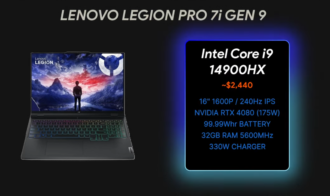Dell Latitude 7330 Ultralight Review
So, you’ve concluded that a Dell Latitude 7330 would be ideal for your professional needs. You haven’t made up your mind yet. The 13.3-inch ultraportable comes in a variety of clamshell configurations, including a 3-pound convertible, a 2.5-pound model made of reinforced carbon fiber, a 2.67-pound model with an aluminum touch screen, and the 2.13-pound Latitude 7330 Ultralight.
Dell Latitude 7330 Ultralight Specs
| Processor | Intel Core i7-1265U |
| RAM | 16 GB |
| Boost Drive Test | SSD |
| Screen Size | 13.3 inches |
| Native Display Resolution | 1,920 by 1,080 |
| Graphics Processor | Intel Iris Xe Graphics |
| Wireless Networking | Wi-Fi 6E |
| Dimensions | 0.67 by 12.1 by 7.9 inches |
| OS | Windows 11 Pro |
| Battery Life | 8:22 |
PROS
- Effortless and effortless
- Ports include HDMI, USB Type-A, and Thunderbolt 4.
- Fair performance
CONS
- Disappointingly dull layout
- The absence of fingerprint or facial recognition logins
- Lacking a card reader
- Typical battery performance
Classical 1080p quality

Compared to today’s popular taller 16:10 or 3:2 aspect ratio screens, the Latitude 7330’s classic 16:9 aspect ratio and full HD (1,920 by 1,080 pixels) display seem positively dated. The entry-level $1,789 configuration has a carbon fiber chassis, a Core i5-1235U processor, 16GB of RAM, a 256GB solid-state drive, and a 250-nit, non-touch display. Standard features include Windows 11 Pro and 6E Wi-Fi.
Price

Our $2,276 Ultralight configuration included a 512GB NVMe SSD, a 400-nit non-touch IPS panel, and an Intel Core i7-1265U processor (two performance cores, eight efficient cores, and 12 threads). The lightest configuration requires a three-cell, 41 WHr battery rather than a four-cell, 58 WHr pack, and it lacks a fingerprint reader and a face recognition webcam, so you’ll have to type your passwords instead of using Windows Hello’s fingerprint and facial recognition features.
Performance

The bottom-mounted speakers are powerful, but the sound is harsh and hollow, with little to no bass and some audible track overlap. The included Dell Optimizer software helps reduce ambient noise during conference calls. Still, it lacks a dedicated equalizer or other audio settings for listening to music or watching movies.
The webcam’s resolution is only 720p, but the images it records are bright, vivid, and not too marred by noise or static. With Dell Optimizer, you can combine wired and wireless connections to boost network speed (a USB adaptor is required for wired connections due to the lack of an Ethernet connector). It has four thermal modes (calm, optimal, quiet, and performance). It can be customized for up to five of your most used programs (we ran our testing in optimized mode first and found a significant performance increase when we switched to performance).
First-Class Quality

For me, the finest aspect of testing the Latitude was not using it but instead taking it around with me. In my backpack, it barely registers as an object. Compared to the consumer-oriented XPS 13 Plus, this one is over half a pound lighter. There are costs associated with that lack of weight. The chassis is flexible all through; it doesn’t seem to be built to MIL-STD 810H requirements, and it has about as much style as a box of Kleenex. However, the Latitude delivers on Dell’s promise of being a lightweight gadget rather than a stylish or durable one.
Screen and battery life evaluations


The Latitude reached eight hours in our battery test but died much sooner than the HP and Apple ultraportables. Its runtime wasn’t bad, but the bigger batteries in the carbon and metal models would be excellent. Its full HD screen had good color and brightness (it was brighter than the 400 nits it was rated for). However, this is not as much as expected in terms of the price it comes with. Overall, the battery life is medium range.
Conclusion
The Dell Latitude 7330 Ultralight is a powerful ultraportable with a fair selection of connectors, and its 1080p display serves as a reminder that older technology can still be appreciated in this day and age of unconventional screen ratios. However, the Ultralight variant lacks the larger battery and additional features of its heavier-set siblings, such as a fingerprint reader and a face recognition webcam, and the 7330 generally lacks the panache of more stylish designs, such as the square-screened HP Dragonfly Elite G3 (admittedly costing a few hundred dollars more). IT directors will like it even if it’s not the most sophisticated solution.

















